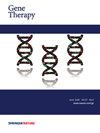聚焦超声广泛拓宽了aav递送的Cas9分布和活性。
IF 4.5
3区 医学
Q1 BIOCHEMISTRY & MOLECULAR BIOLOGY
引用次数: 0
摘要
由于儿童几乎没有时间暴露于环境和衰老,大多数儿童神经系统疾病是固有的,即遗传。由于出生后的神经元和星形胶质细胞大多是不复制的,基因治疗和基因组编辑在儿童神经病学中呈现出巨大的希望。不同于其他器官对腺相关病毒(AAV)的高度容纳,成熟的血脑屏障(BBB)极大地限制了AAV在大脑中的循环分布。鞘内给药改善了脑细胞的分布,但不超过20%。聚焦超声(FUS)可瞬间安全地打开血脑屏障。在本研究中,我们打开海马血脑屏障,通过AAV9在鞘内传递Cas9基因。这允许大脑首先通过,随后血管循环并通过打开的血脑屏障重新进入。使用的小鼠模型是拉福拉病,一种由畸形过长支糖原积聚引起的神经炎性疾病。Cas9靶向糖原分支延长酶糖原合成酶基因。我们发现FUS显著(2000倍)改善了海马Cas9分布,并大大减少了致病性糖原积累和海马炎症。FUS在临床中经常用于其他适应症。我们的工作表明,它具有极大地扩大基因传递或编辑的潜力,同时清除相应的脑部疾病病理基础。本文章由计算机程序翻译,如有差异,请以英文原文为准。

Focused ultrasound widely broadens AAV-delivered Cas9 distribution and activity
Because children have little temporal exposure to environment and aging, most pediatric neurological diseases are inherent, i.e. genetic. Since postnatal neurons and astrocytes are mostly non-replicating, gene therapy and genome editing present enormous promise in child neurology. Unlike in other organs, which are highly permissive to adeno-associated viruses (AAV), the mature blood-brain barrier (BBB) greatly limits circulating AAV distribution to the brain. Intrathecal administration improves distribution but to no more than 20% of brain cells. Focused ultrasound (FUS) opens the BBB transiently and safely. In the present work we opened the hippocampal BBB and delivered a Cas9 gene via AAV9 intrathecally. This allowed brain first-pass, and subsequent vascular circulation and re-entry through the opened BBB. The mouse model used was of Lafora disease, a neuroinflammatory disease due to accumulations of misshapen overlong-branched glycogen. Cas9 was targeted to the gene of the glycogen branch-elongating enzyme glycogen synthase. We show that FUS dramatically (2000-fold) improved hippocampal Cas9 distribution and greatly reduced the pathogenic glycogen accumulations and hippocampal inflammation. FUS is in regular clinical use for other indications. Our work shows that it has the potential to vastly broaden gene delivery or editing along with clearance of corresponding pathologic basis of brain disease.
求助全文
通过发布文献求助,成功后即可免费获取论文全文。
去求助
来源期刊

Gene Therapy
医学-生化与分子生物学
CiteScore
9.70
自引率
2.00%
发文量
67
审稿时长
4-8 weeks
期刊介绍:
Gene Therapy covers both the research and clinical applications of novel therapeutic techniques based on a genetic component. Over the last few decades, significant advances in technologies ranging from identifying novel genetic targets that cause disease through to clinical studies, which show therapeutic benefit, have elevated this multidisciplinary field to the forefront of modern medicine.
 求助内容:
求助内容: 应助结果提醒方式:
应助结果提醒方式:


